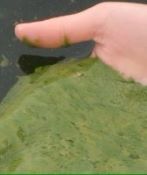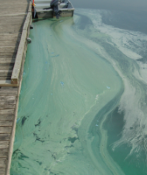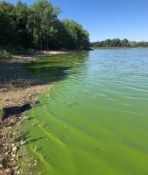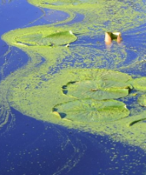Blue-green algae, also called cyanobacteria, are a type of microscopic bacteria that occur naturally in freshwater lakes, bays, ponds, rivers and streams usually beginning in late summer or early fall.
Wellington-Dufferin-Guelph is home to several shallow lakes and other bodies of water that are particularly susceptible to blue-green algae due to higher water temperatures. When combined with nutrient-rich water from agricultural runoff, these water systems provide the ideal environment for blue-green algae to thrive.
The rapid growth of these algae can result in the formation of large masses or scum called “blooms.” Some algal blooms are considered harmful as they may produce toxins that can be harmful to the health of people and pets. There’s no way to tell by looking at a bloom whether it contains toxins or not. As a precaution, regard any blue-green algal bloom as potentially toxic.
You can be exposed to blue-green algae by:
- Direct skin contact (including swimming or recreational activities such as boating, waterskiing or diving)
- Drinking water
- Accidental swallowing of water
- Inhaling mist in the air containing blue-green algae cells or toxins (e.g., waterskiing, showering)
- Eating fish caught in water where blue-green algae occurs
How to recognize blue-green algae
Dense blue-green algae blooms may make the water look like bluish-green, like green pea soup or turquoise paint. When the blooms are very dense, they may form solid-looking clumps. Fresh blooms often smell like newly mown grass; older blooms may smell like rotting garbage.




What to do if you suspect blue-green algae
If you suspect there could be blue-green algae in a body of water you should take the following measures:
- Assume toxins are present
- Avoid using the water:
- Don’t drink the water
- Don’t swim or bathe in the water
- Keep animals out of the water
- Don’t touch or handle the algae
- If swimming near or in the harmful blue-green algal bloom immediately take a shower.
- Consult a healthcare provider if symptoms such as skin, eye or throat irritation, allergic reactions or breathing difficulties; nausea, vomiting or diarrhea develop.
- Report the suspected algae to:
- Grand River Conservation Authority at 519-621-2761
- Ministry of the Environment, Conservation and Parks Spills Action Centre at 1-800-268-6060
- Public Health (toll-free) at 1-800-265-7293 ext. 4753 or by email at PHI.Intake@wdgpublichealth.ca.
- Learn how to identify blue-green algae
Health effects of blue-green algae
Some blue-green algae produce toxins that can pose a health risk to people and animals.
Symptoms include:
- Itchy, irritated eyes and skin
- Headaches, fever, diarrhea, stomach pain, nausea and vomiting
- More serious effects such as liver damage may occur when large amounts are ingested
Please note that infants and young children (under age 6) are most at risk of developing health problems (e.g., liver damage) from exposure to blue-green algae.
What to do if you’re exposed to blue-green algae blooms
- Rinse off with clean water immediately
- Consider speaking with your healthcare provider for symptoms such as skin, eye or throat irritation, allergic reactions or breathing difficulties; nausea, vomiting or diarrhea
- If you are concerned about a pet being exposed to blue-green algae, please contact your veterinarian.
- Report the suspected algae and your symptoms as soon as possible to:
- Grand River Conservation Authority at 519-621-2761
- Ministry of the Environment, Conservation and Parks Spills Action Centre at 1-800-268-6060
- Public Health (toll-free) at 1-800-265-7293 ext. 4753 or by email at PHI.Intake@wdgpublichealth.ca
Where to get more information
